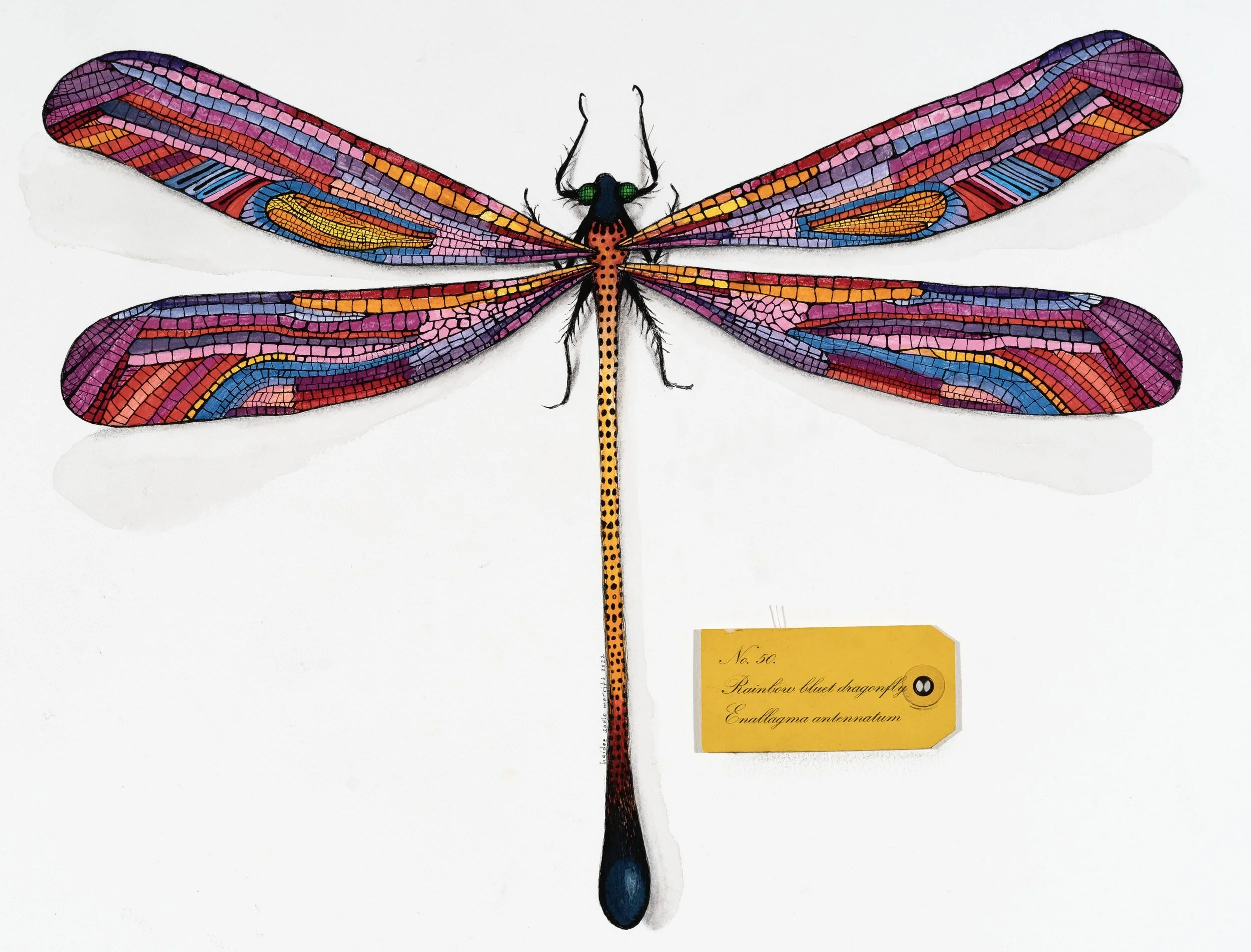 Image 1 of 1
Image 1 of 1


Specimen No. 50 Rainbow Bluet Dragonfly
Specimen No. 50
Catalog No. FD - 23 - 50
Common Name: Rainbow Bluet Dragonfly
Scientific Name: Enallagma aetheronatum
Order: Odonata
Discovered by: Aurelio Saint-Mars, botanical cartographer and aerial surveyor
Date of Collection: 3 February 1909
Locality: Cloud Basin Ridge, Sierra del Oro, Ecuador
—
The Rainbow Bluet Dragonfly was first recorded during a high-altitude survey of equatorial flora led by Aurelio Saint-Mars in early 1909. Hovering at over 1,800 meters, Saint-Mars’ dirigible had anchored above the Cloud Basin Ridge in Ecuador, where he was mapping epiphytic orchids for the Société Botanique de Genève. What caught his eye, however, was not botanical—but aerial: a long-bodied, iridescent creature moving silently beneath the balloon in a perfect glide. Its wings caught the sun at four different angles, each one reflecting a prism of color unlike any insect he’d ever charted.
Later classified as Enallagma aetheronatum—“the bluet of the upper air”—the specimen dazzles in both structure and hue. While bluets are typically modest damselflies, this species breaks every rule of scale. Its slender thorax is stippled with burnt orange and coral, gradually giving way to a deep indigo-blue abdomen. The wings are the true spectacle: latticed mosaics of rose, tangerine, plum, azure, and citron—each wing uniquely patterned, as though stitched from fragments of different sunsets. Observers report that it does not fly in the traditional sense but soars, catching thermals and gliding like a living kite through rarefied air.
Only one confirmed individual was netted by Saint-Mars after it descended briefly to sip from a high-altitude bromeliad pool. The specimen’s coloration, he noted, began to dull within hours of descent—suggesting a kind of altitude-activated iridescence. It remains preserved behind layered glass in a sealed climate case at the Museo de la Nube in Quito. Though never formally accepted into taxonomic canon, Enallagma aetheronatum is whispered about in tropical entonology circles—spoken of with the same reverence reserved for mirages, auroras, and things that may only exist where the sky thins and gliders drift without sound.
Note: High quality archival glicée print on acid-free paper, a method that creates fine art reproductions with exceptional color accuracy and longevity. Pigments-based inks are designed to resist fading and discoloration and capture the finest details and subtle color variations with great precision.
Housed in a 4×6” crystal-clear acrylic specimen block, its 1” depth allows freestanding display. Each piece is designed to exhibit on desk, shelf, or wall.
Fly Design uses a practice known as entonology — the study of fictitious insects — to reimagine the natural world through scientific storytelling and poetic design.
Specimen No. 50
Catalog No. FD - 23 - 50
Common Name: Rainbow Bluet Dragonfly
Scientific Name: Enallagma aetheronatum
Order: Odonata
Discovered by: Aurelio Saint-Mars, botanical cartographer and aerial surveyor
Date of Collection: 3 February 1909
Locality: Cloud Basin Ridge, Sierra del Oro, Ecuador
—
The Rainbow Bluet Dragonfly was first recorded during a high-altitude survey of equatorial flora led by Aurelio Saint-Mars in early 1909. Hovering at over 1,800 meters, Saint-Mars’ dirigible had anchored above the Cloud Basin Ridge in Ecuador, where he was mapping epiphytic orchids for the Société Botanique de Genève. What caught his eye, however, was not botanical—but aerial: a long-bodied, iridescent creature moving silently beneath the balloon in a perfect glide. Its wings caught the sun at four different angles, each one reflecting a prism of color unlike any insect he’d ever charted.
Later classified as Enallagma aetheronatum—“the bluet of the upper air”—the specimen dazzles in both structure and hue. While bluets are typically modest damselflies, this species breaks every rule of scale. Its slender thorax is stippled with burnt orange and coral, gradually giving way to a deep indigo-blue abdomen. The wings are the true spectacle: latticed mosaics of rose, tangerine, plum, azure, and citron—each wing uniquely patterned, as though stitched from fragments of different sunsets. Observers report that it does not fly in the traditional sense but soars, catching thermals and gliding like a living kite through rarefied air.
Only one confirmed individual was netted by Saint-Mars after it descended briefly to sip from a high-altitude bromeliad pool. The specimen’s coloration, he noted, began to dull within hours of descent—suggesting a kind of altitude-activated iridescence. It remains preserved behind layered glass in a sealed climate case at the Museo de la Nube in Quito. Though never formally accepted into taxonomic canon, Enallagma aetheronatum is whispered about in tropical entonology circles—spoken of with the same reverence reserved for mirages, auroras, and things that may only exist where the sky thins and gliders drift without sound.
Note: High quality archival glicée print on acid-free paper, a method that creates fine art reproductions with exceptional color accuracy and longevity. Pigments-based inks are designed to resist fading and discoloration and capture the finest details and subtle color variations with great precision.
Housed in a 4×6” crystal-clear acrylic specimen block, its 1” depth allows freestanding display. Each piece is designed to exhibit on desk, shelf, or wall.
Fly Design uses a practice known as entonology — the study of fictitious insects — to reimagine the natural world through scientific storytelling and poetic design.